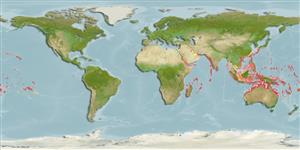>
Eupercaria/misc (Various families in series Eupercaria) >
Labridae (Wrasses) > Corinae
Etymology: Coris: Greek, kore, -es = pupil and also with themenaing of "maid" (Ref. 45335).
More on author: Lacepède.
Environment: milieu / climate zone / depth range / distribution range
Ecologia
marinhas associadas(os) a recifes; intervalo de profundidade 2 - 30 m (Ref. 1602), usually 2 - 30 m (Ref. 27115). Tropical; 24°C - 28°C (Ref. 27115); 30°N - 30°S
Indo-Pacific: Red Sea and East Africa (Ref. 4392) to the Line and Ducie islands, north to southern Japan, south to Lord Howe and Rapa islands.
Tamanho / Peso / Idade
Maturity: Lm ? range ? - ? cm
Max length : 120 cm TL macho/indeterminado; (Ref. 5213)
Espinhos dorsais (total): 9; Raios dorsais moles (total): 12-13; Espinhos anais 3; Raios anais moles: 12. Caudal fin slightly rounded in females, truncate and with filamentous rays in large males; pelvic fins of males very long. Large males also become uniformly dark-green and develop a gibbus forehead and an elongate first dorsal spine (Ref. 1602). Juveniles distinct with the false eyes, shaded by orange (Ref. 48636).
Occurs in the vicinity of sand or rubble patches of exposed outer reef flats, lagoon reefs, and seaward reefs (Ref. 1602), often in semi-exposed surge zones (Ref. 48636). Adults solitary. Juveniles common in shallow tide pools (Ref. 30573). Feeds mainly on hard-shelled invertebrates including crustaceans, mollusks and sea urchins (Ref. 9823). Minimum depth reported from Ref. 27115. Randall (1999, Ref. 33411) question identity of specimens exceeding 70 cm.
Life cycle and mating behavior
Maturidade | Reprodução | Desova | Ovos | Fecundidade | Larvas
Oviparous, with distinct pairing during breeding (Ref. 205).
Randall, J.E., 1999. Revision of the Indo-Pacific labrid fishes of the genus Coris, with descriptions of five new species. Indo-Pac. Fish. (29):74 p. (Ref. 33411)
Categoria na Lista Vermelha da IUCN (Ref. 130435)
Ameaça para o homem
Harmless
Utilização humana
Pescarias: pouco comercial; peixe desportivo: sim; Aquário: Espécies comerciais
Mais informação
ReferênciasAquaculturaPerfil para aquaculturaEstirpesGenéticaElectrophoresesHereditariedadeDoençasProcessamentoNutrientsMass conversion
Ferramentas
Relatórios especiais
Descarregue XML
Fontes da internet
Estimates based on models
Preferred temperature (Ref.
123201): 24.6 - 29, mean 27.5 °C (based on 892 cells).
Phylogenetic diversity index (Ref.
82804): PD
50 = 0.5000 [Uniqueness, from 0.5 = low to 2.0 = high].
Bayesian length-weight: a=0.00813 (0.00475 - 0.01391), b=3.13 (2.98 - 3.28), in cm total length, based on LWR estimates for this species & (Sub)family-body (Ref.
93245).
Nível Trófico (Ref.
69278): 3.7 ±0.53 se; based on food items.
Resiliência (Ref.
120179): Muito baixo, tempo mínimo de duplicação da população maior que 14 anos (Preliminary K or Fecundity.).
Fishing Vulnerability (Ref.
59153): High to very high vulnerability (72 of 100).
Nutrients (Ref.
124155): Calcium = 18.2 [7.0, 45.9] mg/100g; Iron = 0.437 [0.249, 0.789] mg/100g; Protein = 18.8 [15.9, 21.0] %; Omega3 = 0.099 [0.049, 0.200] g/100g; Selenium = 40.8 [15.7, 115.1] μg/100g; VitaminA = 62.6 [18.7, 212.5] μg/100g; Zinc = 1.45 [0.69, 2.60] mg/100g (wet weight);
